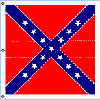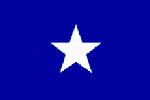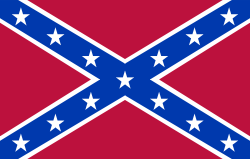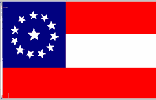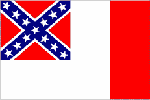Civil War Facts |
Colonial Wars |
American Wars |
Link To This Page — Contact Us —
Confederate Flags
 Battle Flag l Bonnie Blue l Navy Jack l 1st National Flag l 2nd National Flag l 3rd National Flag
Battle Flag l Bonnie Blue l Navy Jack l 1st National Flag l 2nd National Flag l 3rd National Flag
Battle Flag
To remedy this, Gen. P.G.T. Beauregard, of the Army of Virginia, and others sought a better design. He attempted to have the Confederate flag changed but Congressman William Porcher Miles suggested that the army adopt its own distinctive battle flag, and recommended the design he had presented to the Congress as the Confederate Flag on March 4, 1861. This flag was agreed upon, but it was recommended that it would be more convenient and lighter as well as less likely to be tore by bayonets or tree branches if made square. This flag proved so popular, that it became basis for the Second National flag of the Confederacy. Some prefer the square proportions of this flag over Mile's original rectangle as more sonorous and more distinct — and therefore a better symbol of the South. It was used in battle from November 1861 to the fall of the Confederacy. The battle flag of the Confederacy is square, of various sizes for the different branches of the service: 48 inches square for the infantry, 36 inches for the artillery, and 30 inches for the cavalry. Other flags, such as State regimental colors, were used by the Confederacy on the battlefield, but the Battle Flag, although it was never officially recognized by the Confederate government, came to represent the Southern "cause" to most people. |
Bonnie Blue
With this rebellion in mind, this flag was used by the Republic of Texas from 1836 to 1839. On January 9, 1861 the convention of the People of Mississippi adopted an Ordinance of Secession. With this announcement the Bonnie Blue flag was raised over the capitol building in Jackson. Harry McCarthy was so inspired that he wrote a song entitled "The Bonnie Blue Flag" which became the second most popular patriotic song of the Confederacy. The Confederate government did not adopt this flag but the people did and the lone star flags were adopted in some form in five of the southern States that adopted new flags in 1861. |
Navy Jack
The Confederate Navy Jack, also called "The Southern Cross," is rectangular, usually about 5×3 feet. The blue color in the saltire (the diagonal cross) is much lighter than in the Battle Flag, and it was flown only on Confederate ships from 1863-1865. This flag is what is typically recognized as the Confederate flag, but this is not strictly accurate. The design was originally made by South Carolina Congressman William Porcher Miles to be the 1st National Flag, but it was rejected by the Confederate government for looking too much like crossed suspenders. It was used by a few army units, including the Army of Tennessee, as their battle flag. Today, it is the most universally recognized symbol of the South, where it is commonly called the Rebel or Dixie flag. The Southern states or The South, was known during the Civil War era as "Dixie". |
1st National Flag
During battle, this flag was sometimes confused with the Union Stars and Stripes, therefore it was replaced by the 2nd National flag in 1863. |
2nd National Flag
Adopted on May 1, 1863, this flag displayed the Battle Flag in the canton on a field of pure white, giving it it's name the "Stainless Banner", to refer to "the unspotted virtue and honor of Southerners and their fight for independence from the tyranny and aggression of northern states." One of the first uses for this flag was to drape the coffin of Gen. Thomas J. "Stonewall" Jackson. Jackson died on May 10, 1863 from a case of pneumonia that he contracted in the treatment of his injuries received at the Battle of Chancellorsville on May 2nd. On the 12th, his body lay in state in the Confederate House of Representatives, by order of the President Jefferson Davis, the first new flag manufactured draped his coffin. The flag is often referred to as the "'Stonewall' Jackson Flag". This "Stainless Banner" is now on display in the Museum of the Confederacy in Richmond, Virginia. |
3rd National Flag
This design added a red bar to the end of the "Stainless" flag. The red vertical stripe was added to dispel confusion with the flag of surrender when the flag was not unfurled. This flag flew for 36 days in 1865 until the South surrendered on April 9th. The flag was also known as "Stainless". |

